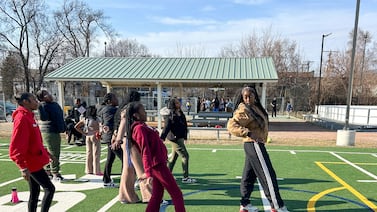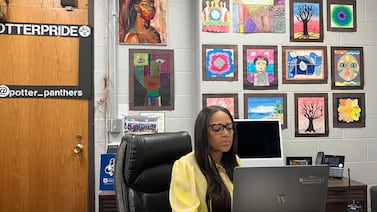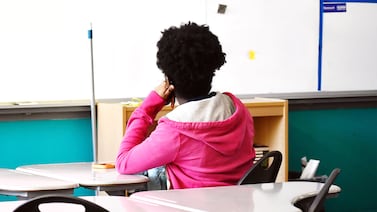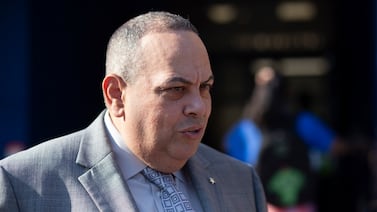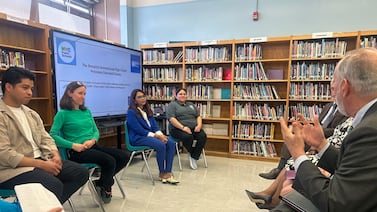A high energy protest at O’Hare International Airport early in the Donald Trump era kicked off author Elly Fishman’s quest to document the lives of refugee teenagers who had resettled in Chicago.
That quest quickly led her to Sullivan High School, a neighborhood public high school on Chicago’s Far North Side. Nearly 40 languages are spoken in the hallways of the campus — a designated “welcoming center” for new arrivals to the United States that offers a social worker specifically for new immigrants and an in-school health clinic.
“The first day I walked into the school, I heard this wall of sound,” she said. “It was Arabic, and Swahili, and Urdu, all mixed up in English. I knew there was a story to tell.”
Her new book “Refugee High: Coming of Age in America” (The New Press; Aug. 10) documents four teenagers and the educators who challenge and comfort them during a tumultuous 2017-2018 year. The teens must confront gun violence, the anxiety of asylum appeals, the expectation of arranged marriage, the demands of balancing late-night jobs and family and school.
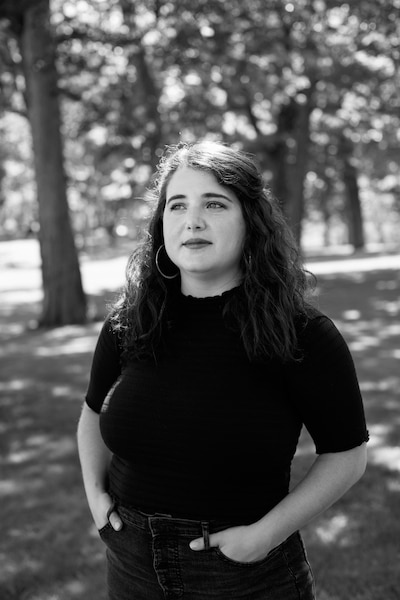
“It’s not a savior story. It’s about a community and an ecosystem and how they lift each other up and support each other — that felt way more real and way more human than a Pollyannaish picture of school,” she said. “So much of it is about the relationships kids have to each other but also the adults in the building. The staff and teachers at Sullivan understand that school is more than curriculum and learning. It’s a community and shelter and safety and mental health services.”
The school must also confront particular challenges. In the excerpt below, Fishman documents an evening at Sullivan when the dynamic principal, Chad Adams, must lead a community conversation about gang recruitment. The author used pseudonyms for names of students and their family members.
Chad leans against the podium at the front of the room packed with Rogers Park community members, most of whom are longtime Chicagoans of every ilk who have come to advocate for their newest neighbors. The meeting, which Chad and Rogers Park Alderman Joe Moore lead together, is a response to the outpouring of concerned, often seething, emails from neighborhood residents. The alderman’s office suggested a meeting where community members could voice their concerns. He titled the event “Support Refugees Resisting Gangs.”
Chad wears a button-down shirt under his navy-blue Sullivan track jacket. The former suited the solemnity of the proceedings and the latter dialed it down. The most urgent questions of the hour —how and why the shooting of a Sullivan high school student named Esengo happened — will be hard to answer. The principal knows that anyone can be a victim. When he worked at Harper High School on the South Side of the city, Chad saw how gun violence traumatized students and their families. He lost count of the number of meetings with parents and neighbors who have wanted answers. He’s heard over and over how gangs appeal to his students. All kids want to fit in, and for many, gang culture promises community and security. It often appeals to the most vulnerable and those who are outsiders. Refugee students are often both unprotected and unfamiliar. At Sullivan, Chad has watched as refugee boys — some from the Congo, others from Myanmar — begin to emulate the styles and cadences of some of their American classmates. Sometimes they don’t even know the meaning of the lingo or the gestures they’re trying on; more than anything, they try to belong. In any case, it signals to gangs that they have a way in. Chad always told himself he needs to expect calls like the one he got after Esengo’s shooting.
From the podium, Chad nods to acknowledge a woman in the front row.
“So, my question is, you said you wished the family of the boy who was shot had reached out to you earlier, and I guess I’m wondering, what could you have done if they did?”
Chad’s answer reflects that he understands the sense of panic among students and their families, and it also asserts the school’s role as one of the students’ protectors. The last thing he wants is for parents to think their children are less safe in school than out of school.
“Hearing from the family would have allowed us to do a little investigation, and make sure it’s not one of our kids,” responds Chad. “It would allow us to get a head start. We could have asked about who beat him up, what they looked like . . . We didn’t have any of that information.” Chad pauses. “I don’t blame the kid for not telling us. The family didn’t know to tell the school. But if we don’t know, we can’t do anything.”
A man toward the back of the room stands up. “The bottom line is a young man ended up getting shot, so what could have been worse than that?”
A staff member from Joe Moore’s office steps in. She explains this is precisely why she set up this meeting: her hope is to connect those working with refugee families with the Sullivan staff. Chad can feel the temperature rise.
“I can give everyone my card,” Chad says from the podium. “I’ll make sure you have my contact information.”
“I volunteer with a Syrian family and they’ve got little kids. I’m wondering does recruitment start at a young age and are there any ideas for little kids?” one woman asks.
“I’m sure it starts early,” Chad responds without any condescension. “But I don’t know what age exactly.”
Just then, a slight man toward the front of the room stands up. “My name is Pastor Jim Larkin, Christ Church,” he tells the room. “We have ten Congolese students attending Sullivan and gang recruitment usually starts around age twelve. What happens when you’re recruited is you get beat up, and [after that] it usually turns into a five-year commitment. You have to go to meetings and pay dues. They say, uh, ‘Once a King, always a King.’”
A voice from the other side of the room adds to the mix. “We also have to be aware that there are a number of African kids who are actually in a gang,” he says. “They speak Swahili. Some are Rwandan, okay. I think we gotta be careful that we don’t say they are totally, you know, American kids sucking in African refugee kids.” He pauses. “And lastly, how come the police are not at this meeting?”
Next, a Congolese man, clutching his shoulder bag against his stomach, chimes in from the back of the room. “My name is John and I work for RefugeeOne. I think this is so difficult for parents coming from Africa. There are cultural issues here and children start going through the school system and they want to adjust and be like other American teenagers. This is hard for parents because they do not speak the language and they do not understand American culture.”
“That’s one of the reasons we asked all of you to be here,” Chad continues. “Education should start at age four. I don’t know what it should look like, but I know it should look something like what we’re doing here. We’re listening to kids and talking about what they see in their neighborhoods. We ask them what they see and if anyone has approached them. That sort of thing.”
“So, it sounds like you’re talking about gangs targeting kids because of being a refugee,” one woman says, without raising her hand. “I was wondering if there’s a pattern for recruitment in terms of certain ethnic groups or certain countries of origin?”
“You know, all kinds of kids are targets,” Chad responds. “Especially ones who walk home by themselves because that’s sort of a sign that you might not have a friend yet in this country, or in this neighborhood. . . . We try to build a sense of family here. But if you haven’t found your way yet, you’re going to be susceptible.”
© Elly Fishman. This excerpt originally appeared in “Refugee High: Coming of Age in America,” published by The New Press. Reprinted here with permission.


